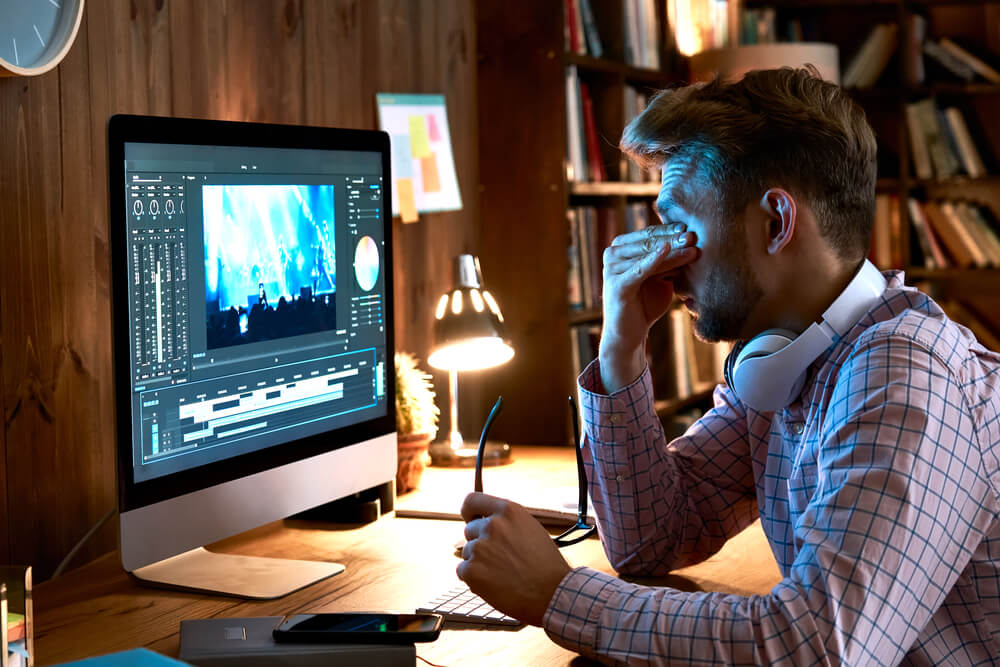Eye strain occurs when your eyes tire from focusing on a single task for an extended period. It’s common among people who use computers, drive long distances, or engage in eye-straining activities like knitting or sewing for a long time. Kids are not exempted from this condition, and pediatric eye care is necessary to keep them healthy.
While it may be uncomfortable, eye strain carries no serious dangers. The condition is easy to manage with some helpful tips. However, it’s worth noting that eye strain symptoms may sometimes mean a different condition that requires the attention of a specialist. Here’s a complete guide to understanding the condition and keeping your eyes healthy.
What Is Eye Strain?

Eye strain, or eye fatigue, is a condition that results from the intensive focus of eyes on single tasks like sewing, reading, or knitting. Also, driving for extended periods is a common cause of the condition.
In recent years, computers and other digital devices like mobile phones, tablets, and iPads have become the most common causes of heavy eyes among children and adults. Also, watching television for a long duration can lead to problems.
Eye strain is characterized by several symptoms, most of which compromise the performance of your eyes and the effectiveness of your vision. In most cases, the condition will make it challenging to concentrate on tasks due to tired eyes or headaches.
The Prevalence of Eye Strain in Today’s Digital World
Today’s children and adults frequently use digital devices. But even before the acceleration of remote working and studies, 83% of children used digital devices for an average of three hours daily. The statistic has significantly increased, with research indicating that almost all Americans use their digital devices for five or more hours each day.
The increased usage of digital devices has come with its share of problems, including the digital eye strain condition. Research indicates that around two out of every three American adults experience digital eye strain symptoms. Also, eight in ten children aged 10-17 often show signs of tired eyes after using a digital device.
What Causes Eye Strain?
Eye strain is typically caused by focusing your gaze on something for an extended time. The eye lens automatically contracts when you keep looking at something closely. Doing this for an extended period limits the amount of time your eyes have to relax, and increases tiredness.
For example, it’s easy to lose track of time when working on your computer, reading an interesting book, or doing a hobby like knitting or sewing. You’ll find yourself sitting in one position and fixing your gaze on a single place for a long period. The lens of your eye stays tense for a long time, causing fatigue and eye strain headaches.
Also, you blink less while focusing on a task, which can also cause eye strain. Blinking distributes and replenishes the tear layer responsible for keeping your eyes moist and sharpening your view.
The more you go without blinking, the higher the chance of your corneal surface drying up and causing a strain in your eye muscles. Exposure to dry air, whether from a moving fan or being in a less-humid room, can also make your eyes dry and cause the condition.
The Role of Prolonged Screen Time in Eye Strain
Extended use of computers and other digital devices is among the most common causes of eye strain, especially in recent years. This situation has led to two other common terms for the condition, digital eye strain (DES) or computer vision syndrome (CVS).
Using a computer for two or more hours continuously in a day puts you at high risk of getting eye strain. Some reasons computers and other digital devices can cause eye strain include the following:
- People blink less while using these devices, leaving their eyes dry
- Many people don’t consider the right viewing angles, and place the device too close or too far away
- Most digital devices have glare or reflection
- Many people don’t know how to balance the contrast between text and background when using the devices
Other Factors That Contribute to Eye Strain
Besides the common causes, poor posture and lighting can lead to heavy eyes. For instance, a poor sitting posture for a long period is a major cause of eye fatigue and pain in the neck, back, or shoulders.
Also, light from the device and the entire room are common contributors to eye strain. For instance, performing a detailed task like sewing or reading in a dimly lit or excessively bright room means you have to overstrain your eyes to see what you’re doing. Excess pressure isn’t healthy for your eyes.
Similarly, reading very small fonts can cause a strain on your eyes and worsen the situation.
Symptoms of Eye Strain
Eye strain symptoms can range from sore eyes to eyelid muscle spasms and blurred vision. However, visual complications like uncorrected vision and naturally dry eyes have similar signs. So you may need to talk to your ophthalmologist about how you feel and receive an accurate diagnosis, especially if recommended remedies don’t improve the situation.
Here are the common eye strain signs and symptoms to look out for:
- Red, itchy, watery eyes
- Blurred vision
- Problem focusing
- Mild eye strain headache
- Sore eyes, neck, back, and shoulders
- Difficulty keeping eyes open
- High sensitivity to light
Treatment and Prevention
Eye strain may be uncomfortable, but the condition is easy to manage and treat. It’s eye fatigue. The biggest part of eye strain relief should be resting your eyes enough and keeping them moisturized. Also, you can consider artificial tears to keep your eyes moist.
Simple and Effective Remedies for Eye Strain Relief
Do you have heavy eyes due to the prolonged focus on a task? Here are some eye strain relief tips to try:
- Take a break from the task and give your heavy eyes time to rest
- Change your working environment to limit bright lighting, reflections, and glare
- Apply a warm, damp washcloth to the tired parts of your eye while closing them (eyes)
- Adjust the font to make reading comfortable and eliminate eye strain headaches
- Wear appropriate prescription glasses to prevent drying; large-frame glasses are perfect for reducing air movement to the corneal surface.
- Buy over-the-counter artificial tears to keep your eyes moist
Tips for Reducing Screen Time and Preventing Eye Strain
Digital screens are among the major causes of eye strain. Here are a few suggestions to keep your eyes healthy while working on the computer:
- Break your work into small portions and take short breaks between the minor tasks
- Practice the 20-20-20 rule. It recommends looking at an object at least 20 feet away for at least 20 seconds after every 20 minutes of concentration on a task
- Blink often. You can attach a note with the word “blink” close to your computer screen to remind you to do it as often as possible
Recommended Exercises and Habits to Maintain Eye Health
You can easily manage eye strain symptoms or prevent the condition by adopting some of the following habits into your lifestyle.
- Take frequent, short breaks from any visually strenuous tasks
- Use a humidifier
- Keep the lighting sufficient for the task you’re doing
- Avoid smoking
- Put your computer screens at or a little below your sight level
- Keep the digital screen a little far away from where you normally hold your reading materials; an arm’s length is ideal for most people
- Keep the screens cleaned and dust-free
- Ensure the display brightness blends well with the lighting in your environment
- Use anti-reflective glasses and glare-reducing screen protectors to reduce reflection and glare
- Use an adjustable chair
- Consider screens that tilt and swivel
When to See a Doctor
Sometimes the symptoms resemble eye fatigue, but the underlying condition isn’t related to the condition. Other reasons to see your doctor include experiencing any of the following:
- A significant change in your vision
- Eye pains and discomfort
- Double vision
The tips in this guide should help you feel better if the problem is eye fatigue. But, if you have tired eyes even after trying the remedies, a full eye exam would be prudent.
The Importance of Detecting and Treating Eye Strain Early
Detecting and treating eye strain early is essential to avoid prolonged discomfort. Also, other eye conditions may have similar symptoms. So identifying eye strain in time will help you better understand any underlying factors and address them before they worsen.
Things to Keep in Mind About Eye Strain Causes and Treatments

Eye strain is common for people who indulge in detail-intensive tasks like driving, reading, sewing, or knitting. Also, computer and other digital device users are at a greater risk of developing the condition.
However, sometimes the symptoms can mean the presence of other visual conditions that require the intervention of an eye specialist. Try the remedies above. If nothing happens, it may be time to visit an eye specialist.
Art of Optiks is a trustworthy partner to help you regain the health of your eyes. We have an experienced eye care team who is ready to help you with your symptoms, and suggest products to help keep your eyes safe. Contact us today to learn more.

